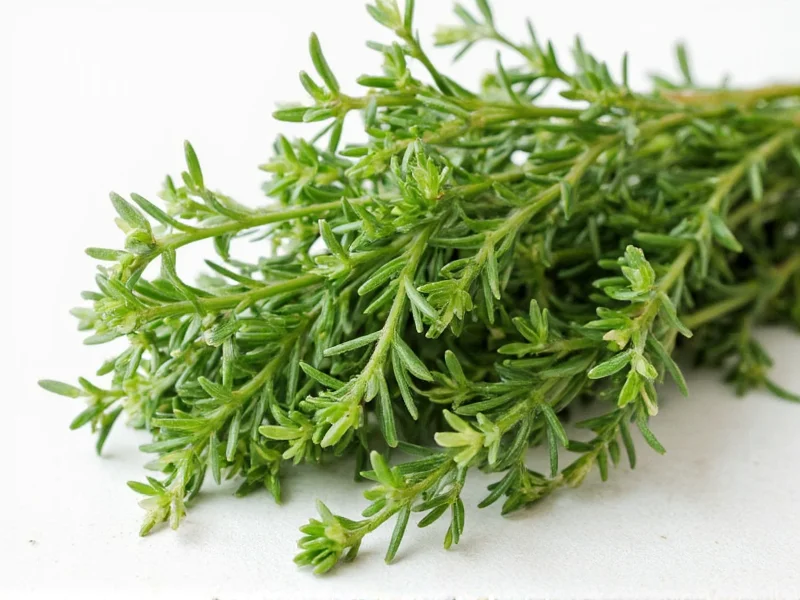Understanding herb measurements is crucial for consistent cooking results, especially when working with delicate flavors like thyme. Many home cooks and professional chefs encounter confusion when recipes call for “a sprig of thyme” without providing precise measurements. This guide clarifies exactly what constitutes a sprig of thyme and how to convert it for various cooking scenarios.
What Exactly Is a Sprig of Thyme?
A sprig of thyme refers to a small, individual stem cut from the thyme plant, typically measuring 4-6 inches in length. This stem includes both the woody portion and the leafy section where the tiny thyme leaves grow. When recipes specify “a sprig,” they’re referring to this entire piece that you would add to dishes like stews, roasts, or infusions.
The confusion often arises because “sprig” isn’t a standardized measurement like teaspoons or grams. Instead, it’s a culinary term that varies slightly based on regional practices and the specific herb being used. For thyme specifically, the sprig’s size remains relatively consistent across most recipe contexts.
Measuring Thyme: Fresh vs. Dried
When converting between fresh and dried thyme, understanding the proper ratios prevents under- or over-seasoning your dishes. Dried herbs generally have more concentrated flavor than their fresh counterparts because the drying process removes water content while preserving the essential oils.
| Thyme Measurement | Fresh Thyme | Dried Thyme |
|---|---|---|
| One sprig | 4-6 inch stem with leaves | 1/4 teaspoon |
| Leaves from one sprig | 1/4-1/2 teaspoon | N/A |
| Standard recipe substitution | 1 tablespoon | 1 teaspoon |
How to Properly Measure Thyme for Recipes
When a recipe calls for “a sprig of thyme,” follow these practical steps to ensure accurate measurement:
- Identify the sprig: Select a healthy stem approximately 4-6 inches long with vibrant green leaves
- Strip the leaves: Run your fingers down the stem to remove leaves if the recipe requires loose leaves
- Measure precisely: For stripped leaves, use 1/4 to 1/2 teaspoon per sprig depending on stem thickness
- Substitute correctly: Replace each fresh sprig with 1/4 teaspoon of dried thyme when converting recipes
Professional chefs often recommend tasting as you go when working with herbs, as thyme’s intensity can vary based on growing conditions, season, and plant variety. English thyme tends to have a more robust flavor than lemon thyme, for example, which might require slight adjustments to measurements.
Common Mistakes When Measuring Thyme
Cooking enthusiasts frequently make these errors when working with thyme measurements:
- Confusing sprigs with stems: A sprig specifically refers to the leafy portion, not just any random stem
- Overpacking dried thyme: Dried thyme should be lightly measured, not packed like brown sugar
- Ignoring recipe context: A sprig used for infusion (then removed) requires different consideration than chopped thyme incorporated into the dish
- Using inconsistent sprig sizes: Try to select similarly sized sprigs when multiple are required for balanced flavor
When following older recipes, remember that measurement standards have evolved. Vintage cookbooks might use “sprig” more loosely than contemporary culinary writing, so consider starting with slightly less thyme and adjusting to taste.
Practical Applications in Cooking
Understanding thyme measurements becomes particularly important in specific cooking techniques:
For braises and stews, whole sprigs work best as they’re easy to remove before serving. The standard ratio is one sprig per serving—so four sprigs for a dish serving four people. As the dish simmers, the thyme infuses the liquid with flavor while the leaves naturally detach from the stems.
In rub preparations for meats, you’ll typically need to strip the leaves from the stems. For a standard chicken or pork rub serving four, you’d use approximately 4 sprigs (about 1-1.5 teaspoons of fresh leaves) combined with other herbs and spices.
When making herb oils or vinegars, the measurement shifts slightly. For every cup of oil or vinegar, use 6-8 sprigs of thyme (equivalent to 1.5-2 teaspoons of dried thyme) to achieve proper flavor infusion without overpowering the base liquid.
Frequently Asked Questions
How many teaspoons is a sprig of thyme?
A single sprig of thyme yields approximately 1/4 to 1/2 teaspoon of leaves when stripped from the stem. The exact amount depends on the thickness of the stem and how densely the leaves grow.
What does one sprig of thyme look like?
A sprig of thyme is a 4-6 inch stem with small, oval-shaped green leaves growing along its length. The stem should be flexible but not woody, with leaves that are closely spaced and vibrant in color.
How much dried thyme equals one fresh sprig?
One fresh sprig of thyme equals approximately 1/4 teaspoon of dried thyme. This conversion accounts for the concentration of flavor that occurs during the drying process.
Can I substitute dried thyme for fresh in recipes calling for sprigs?
Yes, you can substitute dried thyme for fresh. Use 1/4 teaspoon of dried thyme for each sprig of fresh thyme called for in the recipe. Remember that dried herbs have more concentrated flavor, so start with less and adjust to taste.
Should I remove thyme sprigs before serving?
Yes, you should remove whole thyme sprigs before serving most dishes, as the woody stems become tough during cooking and aren't pleasant to eat. If you've stripped the leaves from the stems, no removal is necessary.











 浙公网安备
33010002000092号
浙公网安备
33010002000092号 浙B2-20120091-4
浙B2-20120091-4